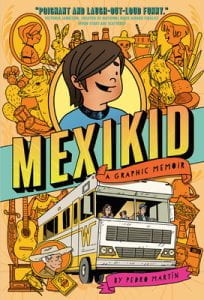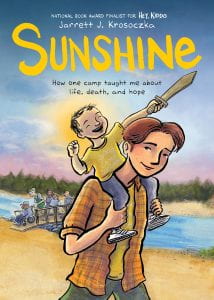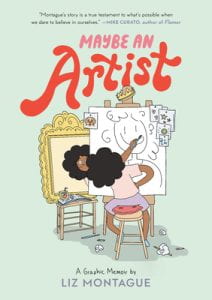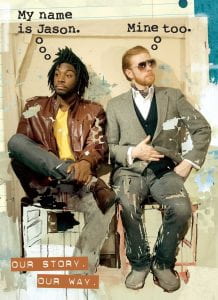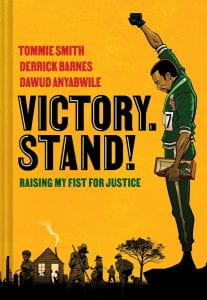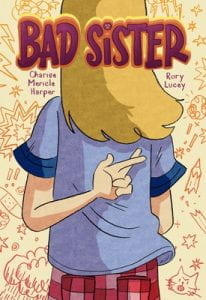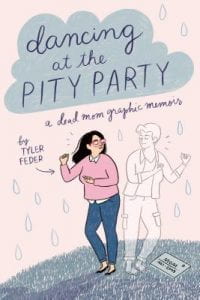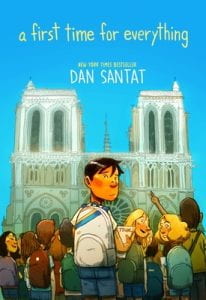 Santat, Dan. A First Time For Everything. First Second Books, 2023. 978-1-626-72415-0. 308 p. $22.99. Grades 5-8.
Santat, Dan. A First Time For Everything. First Second Books, 2023. 978-1-626-72415-0. 308 p. $22.99. Grades 5-8.
Dan is a quiet, obedient boy both in school and at home. His mother is often sick from her struggle with lupus, so Dan helps out when he can. At school, he follows the rules and tries to stay invisible, yet he still finds himself the target of bullying. Dan has never been outside of his small California town, and he sets his expectations low when he attends a class trip to Europe. But despite the fact that the trip gets off to a shaky start, Dan finds his travels to France, Germany, Switzerland, and England are opening his mind to new possibilities. He discovers he loves Fanta, likes French rap, and dislikes getting lost. Dan also discovers he really, really likes Amy, a girl on the trip with him. As he treks through Europe, Dan continues to push himself outside of his comfort zone as he realizes that the world is a big place – and he has a place in it.
THOUGHTS: As a Caldecott-winning illustrator (and author), Dan Santat is a familiar name to librarians. This graphic memoir about his time in Europe is funny, endearing, and relatable. The illustrations are beautifully done, especially his drawings of various European landmarks. Santat even includes back matter: a note from the author and an explanation of how he recreated his old memories in the pages of this book.
Graphic Novel Memoir
Caldecott-award winning author and illustrator (The Adventures of Beekle: The Unimaginary Friend), Dan Santat puts all the cringe-worthy and awkward moments of his middle grade years into the memoir, A First Time for Everything. Docile, obedient, and hard-working, middle-school Dan has a difficult time shrugging off the memory of reciting an A.A. Milne poem in front of the entire student body and being booed. A European tour with other kids his age the summer before high school finally yanks him into living a more typical adolescent life. As the group of mostly white students jaunts from city to city, shy Dan is coaxed to shed his uptight nature, take some risks, make new friends, and welcome the romantic interest of fellow tourist, Amy. When Dan’s camera doesn’t work well, he resorts to keeping a record of his trip in his detailed, realistic sketches. The graphic novel captures the humor of the group, sampling highlights from each country in food or special event. Colored frames represent present day while Dan’s recollections are black and white. Precious memories is the main theme of this lengthy graphic novel (the reader follows the group for 21 days). It sounds cliche, but Dan’s realization that making the most of each moment is genuine. Back matter contains original photographs.
THOUGHTS: The embarrassing moments, the sometimes annoying friends, and the misbehavior of peers will be relatable to most middle school students. There is not much diversity in the book, save for Dan who is Thai-American. His group is from California; the group they travel with is from the Midwest; and they are traveling only through European cities. Dan breaks out of his super rule-consciousness one night and steals a bike, bulking up his courage to sneak into a Wimbledon tennis match where he is center court with John McEnroe. The memoir teaches that each new experience can change us and help us grow, a healthy lesson for those on the brink of high school.
Memoir, Graphic Novel
This coming-of-age story from Caldecott winner Dan Santat shares the true story of his school trip to Europe when he was 14. Having been bullied and feeling invisible in middle school, Dan was not on board with his parent’s idea to travel to Europe with the same classmates who made fun of him. A series of first experiences gradually open Dan up to the world that lies before him. Will these firsts include his first kiss and first girlfriend?
THOUGHTS: A perfect read for the middle school set, this graphic novel will transport you back to all the awkward feelings of middle school and almost make you wish you could go back!
Graphic Novel
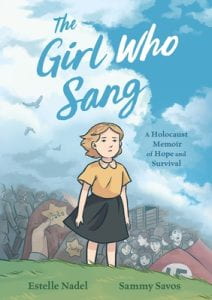 Nadel, Estelle, and Sammy Savos. The Girl Who Sang: A Holocaust Memoir of Hope and Survival. Roaring Brook Press. 2024. 978-1-250-24777-3. 272 p. $18.99. Grades 6+.
Nadel, Estelle, and Sammy Savos. The Girl Who Sang: A Holocaust Memoir of Hope and Survival. Roaring Brook Press. 2024. 978-1-250-24777-3. 272 p. $18.99. Grades 6+.
